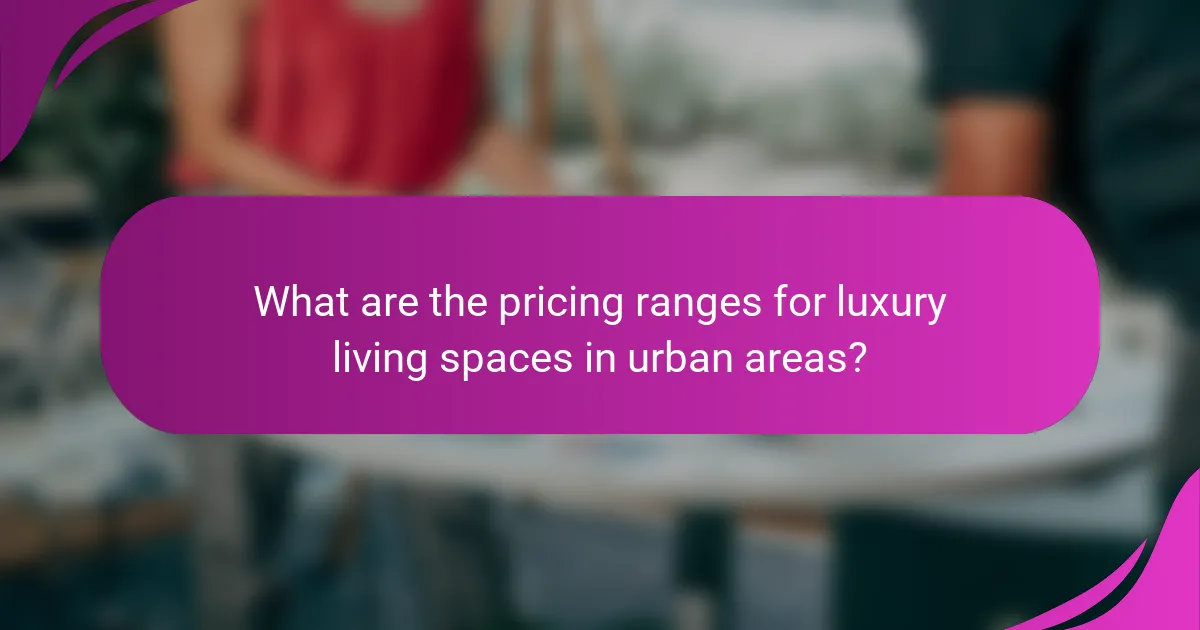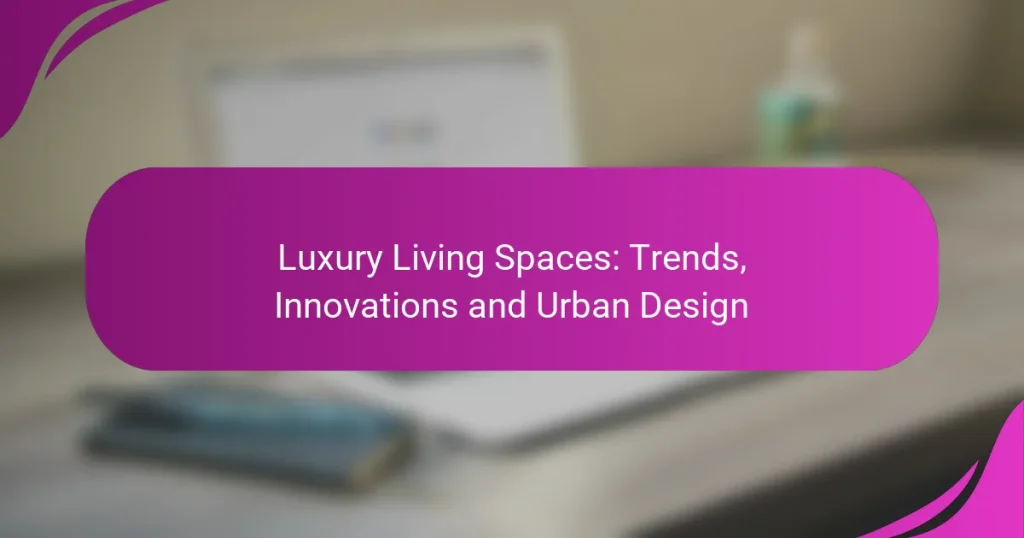Luxury living spaces are evolving to incorporate advanced technology, sustainability, and innovative design, creating environments that prioritize comfort and functionality. As urban design principles shape these spaces, they enhance convenience and community, ultimately improving residents’ quality of life. Innovations such as virtual reality applications and energy-efficient systems further elevate the luxury experience, aligning with modern lifestyles and eco-friendly goals.

What are the latest trends in luxury living spaces?
The latest trends in luxury living spaces focus on integrating advanced technology, sustainability, and innovative design to enhance comfort and functionality. These trends reflect a growing demand for personalized environments that cater to modern lifestyles while prioritizing eco-friendliness and aesthetic appeal.
Smart home technology integration
Smart home technology is increasingly becoming a staple in luxury living spaces, allowing homeowners to control lighting, climate, security, and entertainment systems through their smartphones or voice-activated devices. This integration not only enhances convenience but also improves energy efficiency, as systems can be programmed to optimize usage based on occupancy.
When considering smart technology, look for systems that offer compatibility with various devices and platforms. Popular choices include smart thermostats, security cameras, and automated lighting systems. Be mindful of potential cybersecurity risks and ensure that your network is secure.
Sustainable materials and design
Sustainability is a key focus in luxury living, with many developers opting for eco-friendly materials and energy-efficient designs. This includes using reclaimed wood, recycled metals, and low-VOC paints, which contribute to healthier indoor environments and reduced environmental impact.
Homeowners should consider certifications like LEED (Leadership in Energy and Environmental Design) when selecting materials and designs. Investing in sustainable features may have higher upfront costs but can lead to long-term savings through reduced energy bills and increased property value.
Open floor plans and multifunctional spaces
Open floor plans are popular in luxury homes, promoting a sense of spaciousness and facilitating social interaction. These designs often incorporate multifunctional spaces that can adapt to various needs, such as home offices, gyms, or guest suites.
To maximize functionality, consider furniture that serves multiple purposes, such as a sofa bed or a dining table that can expand for larger gatherings. This flexibility allows homeowners to customize their living spaces according to their lifestyle and preferences.
Biophilic design elements
Biophilic design emphasizes the connection between nature and indoor environments, incorporating natural elements like plants, water features, and natural light. This approach not only enhances aesthetic appeal but also promotes well-being and reduces stress.
Incorporating biophilic elements can be as simple as adding indoor plants or using large windows to bring in natural light. Consider features like green walls or living roofs for a more immersive experience. These elements can significantly enhance the overall atmosphere of luxury living spaces.
High-end amenities and services
Luxury living spaces often include high-end amenities such as fitness centers, spas, and concierge services that cater to residents’ needs. These features enhance the overall living experience, providing convenience and a sense of exclusivity.
When evaluating properties, consider the range of amenities offered and how they align with your lifestyle. Access to services like on-site maintenance, personal trainers, or gourmet dining can significantly elevate the luxury experience and justify higher property values.

How are urban design principles shaping luxury living?
Urban design principles are significantly influencing luxury living by creating environments that prioritize convenience, aesthetics, and community. These principles focus on integrating residential spaces with amenities and services, enhancing the overall quality of life for residents.
Mixed-use developments
Mixed-use developments combine residential, commercial, and recreational spaces within a single area, promoting a vibrant lifestyle. These projects often feature luxury apartments alongside shops, restaurants, and offices, allowing residents to enjoy amenities within walking distance.
When considering mixed-use developments, look for those that balance residential comfort with commercial vibrancy. Successful examples can be found in urban centers where high-end living meets essential services, creating a seamless lifestyle experience.
Walkability and public transport access
Walkability and access to public transport are crucial in luxury living spaces, as they enhance convenience and reduce reliance on cars. Areas designed for pedestrians often feature wide sidewalks, green spaces, and easy access to transit options, making daily commutes more manageable.
To evaluate walkability, consider the proximity of essential services like grocery stores, parks, and dining options. A well-connected public transport system can significantly increase property value and desirability, especially in metropolitan areas.
Community-focused spaces
Community-focused spaces foster social interaction and a sense of belonging among residents, which is essential in luxury living. These areas may include parks, community centers, and shared amenities that encourage engagement and collaboration.
When selecting a luxury living space, prioritize developments that incorporate communal areas designed for gatherings and events. This not only enhances the living experience but also builds a supportive neighborhood culture, which can be a significant draw for potential residents.

What innovations are driving luxury living experiences?
Innovations in technology and design are significantly enhancing luxury living experiences. Key advancements include virtual and augmented reality applications, as well as energy-efficient systems that cater to modern lifestyles and sustainability goals.
Virtual reality in property showcasing
Virtual reality (VR) is transforming how luxury properties are showcased, allowing potential buyers to immerse themselves in a space without being physically present. This technology enables virtual tours that can highlight the unique features and design elements of a property, making it easier for clients to visualize their future home.
Real estate agents can use VR to create engaging experiences that save time and resources. For instance, high-end listings can be showcased in 3D, allowing clients to explore different layouts and finishes at their convenience. This can lead to quicker decision-making and increased interest in premium properties.
Augmented reality for interior design
Augmented reality (AR) is enhancing interior design by allowing homeowners to visualize changes in real-time. With AR applications, users can overlay digital images of furniture, colors, and decor onto their existing spaces using smartphones or tablets, making it easier to experiment with different styles.
This technology can help avoid costly design mistakes by providing a clear picture of how new elements will look in a home. For example, a homeowner can see how a new sofa fits into their living room before making a purchase, ensuring that it complements the existing decor and layout.
Advanced energy-efficient systems
Advanced energy-efficient systems are becoming a hallmark of luxury living, focusing on sustainability without sacrificing comfort. Smart home technologies, such as automated lighting, heating, and cooling systems, help optimize energy use while providing convenience and control.
Investing in these systems can lead to significant long-term savings on utility bills and increase the property’s value. Homeowners should consider options like solar panels, energy-efficient appliances, and smart thermostats, which can reduce energy consumption by a notable percentage, contributing to both environmental sustainability and cost-effectiveness.

How to choose the right luxury living space?
Choosing the right luxury living space involves evaluating various factors such as location, amenities, and market trends. Prioritize what matters most to you, whether it’s proximity to urban centers, high-end facilities, or investment potential.
Assessing location and neighborhood
The location of a luxury living space significantly impacts its value and your lifestyle. Consider factors like accessibility to public transport, proximity to shopping districts, and the overall safety and reputation of the neighborhood.
Research local amenities such as parks, restaurants, and cultural attractions. A desirable neighborhood often enhances the living experience and can lead to better resale value.
Evaluating amenities and services
Luxury living spaces typically offer a range of amenities that enhance comfort and convenience. Look for features like fitness centers, pools, concierge services, and security systems.
Consider how these amenities align with your lifestyle. For example, if you travel frequently, a property with a reliable concierge service may be more beneficial than one without. Make a checklist of must-have amenities to guide your decision.
Understanding market trends
Staying informed about market trends is crucial when selecting a luxury living space. Analyze recent sales data, price fluctuations, and emerging neighborhoods to gauge potential investment returns.
Consult local real estate experts or online resources to track trends in luxury properties. Understanding the market can help you make a more informed decision and potentially negotiate better terms.

What are the pricing ranges for luxury living spaces in urban areas?
Luxury living spaces in urban areas typically range from high six figures to several million dollars, depending on the city and specific location. Factors such as square footage, amenities, and neighborhood desirability significantly influence these prices.
Factors Influencing Pricing
Several key factors determine the pricing of luxury living spaces. Location is paramount; properties in prime urban centers or prestigious neighborhoods command higher prices. Additionally, the quality of construction, architectural design, and available amenities, such as concierge services or fitness centers, can further elevate costs.
Market demand also plays a crucial role. In cities with a high influx of wealthy residents, such as New York or San Francisco, prices can escalate rapidly. Conversely, emerging markets may offer luxury options at more accessible price points.
Typical Price Ranges by City
In major cities, luxury living spaces can vary significantly. For instance, in New York City, prices for luxury apartments often start around $1 million and can exceed $10 million for penthouses. In contrast, cities like Miami may offer luxury condos starting at approximately $500,000, with high-end options reaching several million.
European cities also showcase diverse pricing. In London, luxury properties can range from £1 million to over £20 million, while in Berlin, prices for upscale apartments typically start around €800,000.
Common Pitfalls to Avoid
When considering luxury living spaces, avoid underestimating additional costs such as property taxes, maintenance fees, and homeowners’ association dues. These can significantly impact overall affordability.
Another common pitfall is neglecting to research the neighborhood thoroughly. Factors like future development plans or local amenities can affect property value and quality of life. Always conduct due diligence before making a purchase.


